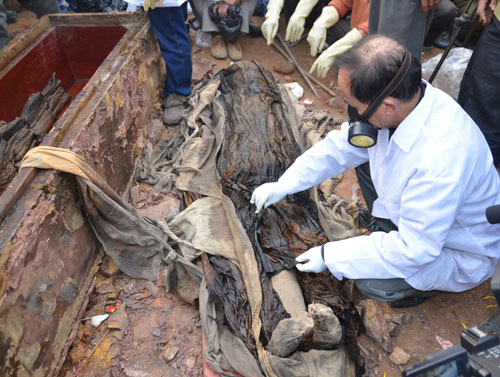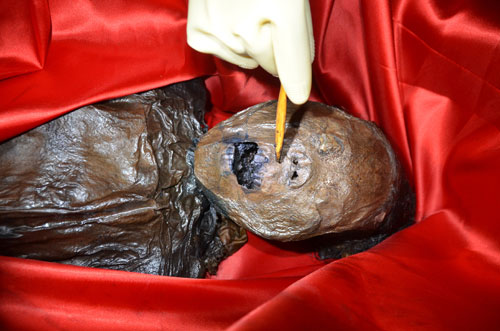Khai excavated an ancient tomb for 300 years in Hanoi
A few days ago, people in Phu My village (Ngoc My, Quoc Oai) talked about the tomb dating back about 300 years, inside there was a coffin containing the body of the woman who was quite intact, showing techniques elaborate burial of the ancients.
The tomb is said to be of the Doan family. "At 10pm on December 10, we brought the burial tools to the mound of Dam Danh in the presence of the authorities and relatives. The Doan family planned to build a new and spacious grave site. " , Doan Manh Ha, 15th generation descendant of Doan family.

Dr. Nguyen Lan Cuong and his colleagues examined the body.(Photo provided by Dr. Cuong)
In the afternoon of December 7, during the construction of excavation of the road to make inland waterway traffic on the field of Chieng, suddenly the excavator hit the grave which lost its mushroom and revealed the coffin.
At the request of the locality, Hanoi Museum and Associate Professor, Dr. Nguyen Lan Cuong, General Secretary of Vietnam Archeology Society came to investigate the situation. After making spiritual procedures, at 15:15 pm on December 10, Mr. Cuong and his colleagues opened the lid of the ancient coffin in the presence of about three to four thousand local people.
The body inside the coffin is quite intact, two toes are tied together and caged in socks made of raw cloth. The coffin of the coffin, nearly broken due to the impact of the excavator, is a coffee-colored milk and is very smooth."The other quách are often clear of roasted or lime rice grains around the rough, but this is very smooth and solid , " Cuong said.

The body is still in its hair and is an intact mass.(Photo provided by Dr. Cuong)
Flip the lid, the science group sees the top layer connected to the body of the coffin with a solid wooden pin, underneath the thin layer of board. Open the thin plank layer, you see the body wrapped with three gauze blankets and tie the knot on your belly. " Because the excavator has a strong impact, the water inside has flowed out, the cloth is wet and easy to tear. We brought it to the museum to dry and study the water sample," Cuong said.
The archaeologist speculated that the body was of a woman about 1m65 tall, wearing about 10 shirts and a pair of pants, long hair, black-dyed teeth, and in the mouth of the molten coins, the experts could not see the words. write in money.
In the coffin, the old people inserted dozens of rolls of paper; both sides of the temple are two fabric pillows, inside are cotton. Another cloth pillow is 60cm long and 10cm in diameter placed between the legs of the body.
"In our opinion, the burial technique was only available in the Later Lê period, not in Lý or Trần's life, with a date dating back about 300 years. In the south, it can be extended later than the Nguyễn period still has the image. This burial practice, " Cuong said.
Another point of attention, according to Mr. Cuong, is that graves often have artifacts, but the tomb in Quoc Oai does not."This type of burial is usually of Buddhist people, or rich people, or kings, but the poor cannot be buried like that," Cuong stressed.
Before the tomb was supposed to belong to the Doan family, there were many people from other places who came to receive it, including the family of Dang Tran and Nguyen Luong . However, these families were unfounded, so they had withdraw.

Mr. Ha looked in the genealogy to record and prove the tomb is of the Doan family.(Photo: Huong Thu)
According to Mr. Manh Ha, the Doan family has full records in the genealogy. Many elderly people in the village also made it clear that the old grave is the family's grave. " In addition, elderly people still remember the graves of the family in the area," Mr. Ha added. On the other hand, scientists' conclusions about tomb dates correspond to the time of the grandmother's loss.
According to the genealogy, the grandmother named Nguyen Thi Da, belonging to the 4th generation, was named Kien Kien, and was granted a sub-title. Her husband named Dang Khoa, whose name was Thai Hoa, lived 31 years old and died on August 3.
Regarding the grandmother, the genealogy wrote: "Five years old (28 years old) met at the yoke of woe (husband was plotted by the people), relatives did not have anyone, the young children. worshiping her husband, the eldest child goes to school, the second child goes to plow, every child makes it.

The genealogy of the Doan family has a full record of Mrs. Nguyen Thi Da.(Photo: Huong Thu)
Regarding the issue of determining which female body of the family is, according to Dr. Nguyen Lan Cuong, it is not difficult, just take a hair sample to test DNA can give an accurate conclusion.

The ancient tomb was discovered at the Chuong village of Phu My village (Ngoc My commune, Quoc Oai district, Hanoi) while doing field irrigation.

Outside frying an ancient coffin is a kind of strong compound, when separated from the wood, it gives off a sweet scent.

The celestial lid is pinned by 4 X-shaped wooden locks;When turned on, there was another board underneath, the coffin was still very fresh.

The dead body was tightly packed with many layers of cloth and inserted with scrolls of paper.

Thousands of people are too curious to rush to see, making Associate Prof. Dr. Nguyen Lan Cuong call for a stable recovery for the experts to work.

The dead body was taken out of the coffin, still in the form of a dried mummy, long hair intact like a person's hair in sleep.

The feet of the deceased person are intact, with their toes and toes.

After being examined, the dead body was returned to the ancient coffin.
- Khai buried a 1,300-year-old tomb of the Chinese prince
- China excavated the tomb of Qin Shihuang's grandmother
- Results of the first ancient tomb excavation in Ben Tre province
- The skeleton is nearly two meters in the tomb of 5,000 years in China
- The secret of an ancient tomb is 800 years old in China
- Horse cars, antiques in the tomb of 2,500 years of the prince in France
- Excavation of the pre-Inca aristocratic tomb
- 4,000 year old tombs in Xinjiang
- The ancient tomb on Buoi Street is over 1,000 years old?
- Excavation of the grave involves Alexander the Great in Greece
- Discovering the burial custom of marijuana in a 2,500-year-old tomb
- Mysterious rooster statue in ancient Roman tomb
 Discovered an ancient centipede fossil 99 million years old
Discovered an ancient centipede fossil 99 million years old Discovered bat-like dinosaurs in China
Discovered bat-like dinosaurs in China Discovered a 200-year-old bronze cannon of the coast
Discovered a 200-year-old bronze cannon of the coast Discover 305 million-year-old spider fossils
Discover 305 million-year-old spider fossils